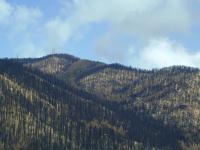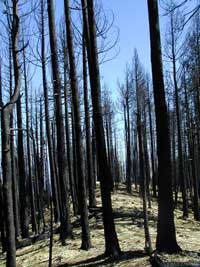
The aftermath of the Aspen Fire, a large and severe forest fire that occurred in the summer of 2003 in the Santa Catalina Mountains near Tucson, Ariz.Large forest fires have occurred more frequently in the western United States since the mid-1980s as spring temperatures increased, mountain snows melted earlier and summers got hotter, according to new research.
Almost seven times more forested federal land burned during the 1987-2003 period than during the previous 17 years. In addition, large fires occurred about four times more often during the latter period.
The research is the most systematic analysis to date of recent changes in forest fire activity in the western United States. The increases in fire extent and frequency are strongly linked to higher March-through-August temperatures and are most pronounced for mid-elevation forests in the northern Rocky Mountains.
The new finding points to climate change, not fire suppression policies and forest fuel accumulation, as the primary driver of recent increases in large forest fires.
"I see this as one of the first big indicators of climate change impacts in the continental United States," said research team member Thomas W. Swetnam, director of the Laboratory of Tree-Ring Research at The University of Arizona in Tucson.
"We're showing warming and earlier springs tying in with large forest fire frequencies. Lots of people think climate change and the ecological responses are 50 to 100 years away. But it's not 50 to 100 years away -- it's happening now in forest ecosystems through fire."
The researchers found the wildfire season is now starting earlier, fires are lasting longer and the fire season is ending later.
"The length of the fire season has increased almost two-and-one-half months compared with 1970 to 1986," Swetnam said. "That's a remarkable thing in itself."
In recent years, wildfires in the western United States have burned hundreds of homes annually and caused extreme and sometimes irreversible damage to natural resources. Fire-fighting expenditures for wildfires now regularly exceed one billion dollars per year.
The research report will be published in the July 6 issue of Science Express, the online version of the journal Science. Anthony L. Westerling of Scripps Institution of Oceanography in La Jolla, Calif., led the research team, which included Scripps scientists Hugo G. Hidalgo and Daniel R. Cayan and UA's Swetnam. The National Oceanic and Atmospheric Administration, the U.S. Forest Service and the California Energy Commission funded the research.
The fire management and scientific communities have thought that U.S. forest fires have been increasing since the 1980s. Research to explain such fires has focused on either climate or 19th-and-20th century land-use practices, such as livestock grazing, logging and fire suppression.
To see what role climate might play, the Scripps-led research team compared western U.S. fire history, the timing of snowmelt, and spring and summer temperatures for the 34 years from 1970 to 2003.
From wildfire data covering western U.S. Forest Service and National Park Service lands, the researchers compiled a comprehensive time series of 1,166 forest wildfires of at least 1,000 acres that had occurred between 1970 and 2003.
To figure out the timing of peak snowmelt in the mountains for each year, the researchers used the streamflow gauge records from 240 stations throughout western North America. 
The aftermath of the Aspen Fire, a large and severe forest fire that occurred in the summer of 2003 in the Santa Catalina Mountains near Tucson, Ariz.
The team also used other climatic data including seasonal temperature observations and moisture deficit, an indicator of dryness.
The researchers determined that year-to-year changes in wildfire frequency appear to be strongly linked to annual spring and summer temperatures and to the timing of spring snowmelt.
"At higher elevations what really drives the fire season is the temperature. When you have a warm spring and early summer, you get rapid snowmelt," Westerling said. "With the snowmelt coming out a month earlier, areas get drier overall. There is a longer season in which a fire can be started and more opportunity for ignition."
The researchers found that 56 percent of the wildfires and 72 percent of the total area burned occurred in early snowmelt years. By contrast, years when snowmelt happened much later than average had only 11 percent of the wildfires and 4 percent of the total area burned.
Climate model projections suggest warmer springs and summers are more likely to occur in the West, amplifying the region's vulnerability to wildfires, the researchers note in their article.
The researchers suggest that more severe fires could change forest composition so drastically that the western forests, which currently store atmospheric carbon dioxide, could become a source of atmospheric CO2. Additional carbon dioxide could further warm the climate and exacerbate the fire problem.
Swetnam was initially skeptical that climate was driving recent large-scale changes in fire frequency. Doing this research changed his mind.
"I had thought it was primarily fuel load. These results suggest that for most western U.S. forests, climate is a primary driver and fuel is secondary." He added, "In the Southwest we know we have a fuel problem. You lay on top of that warming temperatures and now we have the worst of both situations -- changed forests and changed climate."
Source : University of Arizona
 Print Article
Print Article Mail to a Friend
Mail to a Friend
